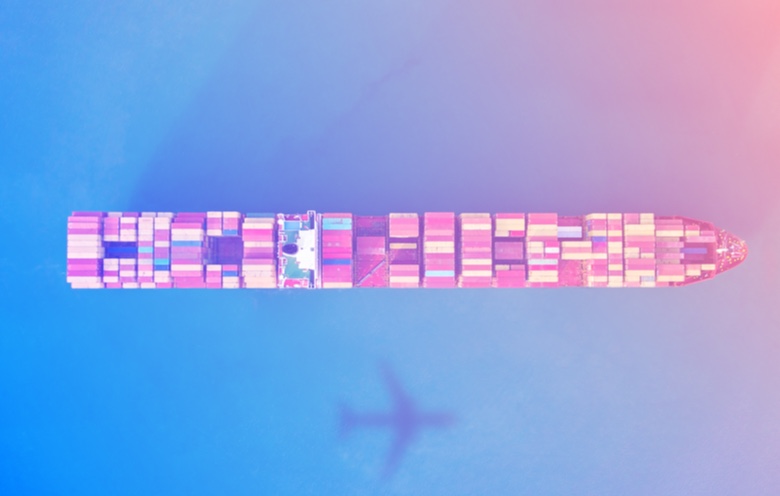Our goals
To develop and validate a new high-technology cosmic ray tomography (CRT) scanner for border guard, customs and law enforcement authorities (LEAs); alongside a novel and compact system to detect special nuclear material (SNM) during transit.
The new scanner enables safe and fast screening, detection and identification of hazardous and illegal goods, contraband as well as hidden persons in up to 20’ iso containers.
The novel scanner and SNM detector will fill the gap in security scanning where widely used conventional x-ray scanners are inefficient for fast scanning of high thickness goods filling the intermodal shipping containers. The scanner will outperform existing systems based on cosmic rays by implementing high performance novel algorithms combined with artificial intelligence for materials and SNM identification and application of cost-effective approach for construction the system to make its price attractive for wide pre-placement of existing x-ray scanners; addressing operative scenarios beyond the current technological research.
The novel system will compete with the widely used conventional x-ray scanners systems to provide an alternative to the inherent technological shortcomings. For example, use of hazardous artificial ionizing radiation, insensitive to elemental composition, impermeable through thick or dense materials, imaging blurring in the pile of materials. And as a result, provide a tomographic, elemental sensitive material classification system. It will allow automated detection of illegal goods, including drugs, explosives, weapons, hidden tobacco and alcohol products as well heavily shielded or masked nuclear material. After field tests the new tomography scanner will be ready for product development and commercialization. After the project, it is envisioned to scale system to accommodate truck and train car sized objects.
The developed sea container scanner system will:
- Be light-weight, compact and smoothly transportable to be easily deployed by customs or border guard authorities. This will be achieved by using the scintillating fibers detector concept for muon tracking that reduces the need for heavy construction materials (steel or aluminium). Latter can be replaced, were possible, with low-Z based composite materials.
- Detect with unprecedented accuracy and speed SNM, performing isotope identification and also analyzing the method used to hide the source, either by shielding it with thick/dense material or by masking it using radioactive sources nearby.
- Be based on natural cosmic ray tomography technology that is inherently safe for people, animals and food, it will enable 100% scanning of cargo and persons.
- Increase the acquired tomogra physignal by 10-fold, as proven in low dose computed tomography(CT) applications in comparison to conventional methods thanks to the tomographic reconstruction that will be based on deep convolutional networks (DCN).
- Offer significantly faster scanning times compared to industry standard x-ray systems – the initial clearance could be received as fast as in 2-3 minutes dependent on authority defined contraband and its size in comparison to 20-30 minutes length of scanning procedure with x-ray scanners.
- Generate full 3D images of the scanned volume as it is a tomography system.
- Automated decisions on material classification will be made by an artificial intelligence AI system with no need for operator interpretations.
- Support automated customs procedures. With integrated to customs information system scanner
- Provides automated confirmation of container contents and its accordance to customs declarations. And vice versa, information from the customs systems (e.g. any earlier x-ray scan or customs declaration) will be used as additional information in the tomographic reconstruction procedure.
- Be designed to achieve the cost-effective design of future commercial systems to compete with X-ray scanners.
- Have low maintenance costs as free of high hazardous voltages requiring no gas supplying service.
Creative direction
Silent Border is :
- The future of non-intrusive inspection for cargo.
- A project lead by multi-disciplinary experts in the areas of research, operations and commercial aspects of the non-intrusive inspection field.
- A human radiation safe alternative to support cargo scanning.
- A full smart solution that relies on advanced AI technologies.
- The perfect complement to the existing X-ray operations around the world.
Our audience
This project is of interest to various parties ranging from scientific research organisations border guard, customs and law enforcement authorities (LEAs). The SilentBorder objectives can only be reached through close collaboration connecting top-level research groups and commercial players at the international level. In addition to partners individual competences, the geographical distribution of LEA partners is selected specifically to suit the call, in terms of EU outer borders – Estonia, Finland, Turkey. In addition, Germany, Belgium, Italy, Switzerland and also the UK are represented with their complementary excellence.
The value chain is represented from the research providers, tool developers, and service providers to the LEA end-users. The project consortium is very well balanced in terms of academic and industrial participation. In particular, the consortium includes:
- 4 research organisations: 3 universities (UT, UCL, USFD) whereby the coordinator (UT) is located in the main demo country of Estonia and will have a full overview of both, construction and the demonstration process. The demonstration work package itself will be led by the research centre (DLR) who has a vast experience in large demo projects.
- 3 industrial partners- wherefrom 2 are spin-offs: GScan from GoSwift which is an innovative SME developing passive and modular tomography system for future security arrangements. And CAEN from INFN designing and manufacturing sophisticated electronic equipment and nuclear instrumentation. And the world’s leading inspection, verification, testing and certification company SGS.
- The consortium is formed of research institutions and organisations carefully selected on the basis of the required skills and resources necessary for the successful execution of the project. Each partner complements the other with some additional resources, know-how and skills. Table 5 lists the roles as well as main competence areas of SilentBorder partners. The administrative capacity for the successful implementation of the project will be ensured by UT, having a very successful track-record in coordinating and participating in EU’s R&D projects. All the partners will equally contribute also to dissemination and exploitation activities.
- And last, but not least: 3 LEA end-users all representing countries with EU outer borders.

